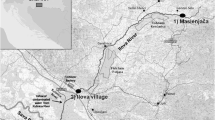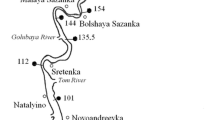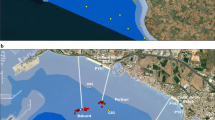Abstract
Analysis of 59 surface sediment samples from the Polish exclusive economic zone (EEZ) shows that Szczecin Lagoon sediments are the most polluted by heavy metals and that the degree of heavy-metal pollution decreases substantially on passing from the Szczecin Lagoon to the Pomeranian Bay and the inner shelf area and then on passing to the Bornholm Deep and Słupsk Furrow. Heavy-metal pollution in the sediments of the western part of the Polish EEZ therefore appears to follow the dispersion of the Oder River. Fluffy material from the Oder estuary appears to be the main source of heavy metals in the muddy sediments of the Bornholm Deep. The formation of sulphides is therefore not the principal factor controlling the enrichment of heavy metals in the sediments of this anoxic basin, although it may be responsible for the uptake of Mo, Sb and As. Two main factors control the distribution of the rare earth elements (REE) in sediments of the Polish EEZ: the input of Fe-organic colloids from rivers and the presence of detrital material in the sediments.



Similar content being viewed by others
References
Aitchison J (1986) The statistical analysis of compositional data. Chapman and Hall, London, pp 416
Andrulewicz E, Lamp J (1994) Odra/Szczecin Lagoon—spoiled but hopeful green link to the Baltic. WWF Balt Bull 1/94:29–34
Andrulewicz E, Chubarenko BV, Zmudzinski L (1994) Vistula Lagoon—a troubled region with great potential. WWF Balt Bull 1/94:16–21
Anon (1995) Bedrock of Sweden. National atlas of Sweden. Geological Survey of Sweden
Beszczyńska-Möller A (1999) Transport of the Odra River waters and circulation patterns in the Pomeranian Bay. Oceanologia 4:279–308
Brookins DG (1998) Eh, pH diagrams for Geochemistry. Springer-Verlag, Berlin, pp 176
Brügmann L, Matschullat J (1997) Zur Biogeochemie und Bilanzierung von Schwermetallen in der Ostsee. In: Matschullat J, Tobschall HJ, Vogt H-J (eds) Geochemie und Umwelt Relevante Prozesse in Atmo-, Pedo- und Hydrosphäre. Springer-Verlag, Berlin, pp 267–289
Brügmann L, Hallberg R, Larsson C, Löffler A (1997) Changing redox conditions in the Baltic Sea deep basins: impacts on the concentration and speciation of trace metals. Ambio 26:107–112
Brügmann L, Hallberg R, Larsson C, Löffler A (1998) Trace metal speciation in sea and pore water of the Gotland Deep, Baltic Sea, 1994. Appl Geochem 13:359–368
Christiansen C, Edelvang K, Emeis K, Graf G, Jähmlich S, Kozuch J, Laima M, Leipe T, Löffler A, Lund-Hansen LC, Miltner A, Pazdro K, Pempkowiak J, Shimmield G, Shimmield T, Smith J, Voss M, Witt G (2002) Material transport from the nearshore to the basinal environment in the Southern Baltic Sea—I: processes and mass estimates. J Mar Syst 35:133–150
Emeis K, Christiansen C, Edelvang K, Jähmlich S, Kozuch J, Laima M, Leipe T, Löffler A, Lund-Hansen LC, Miltner A, Pazdro K, Pempkowiak J, Pollehne F, Shimmield T, Voss M, Witt G (2002) Material transport from the nearshore to the basinal environment in the Southern Baltic Sea—II: synthesis of data on origin and properties of material. J Mar Syst 35:151–168
Erickson BE, Helz GR (2000) Molybdenum (VI) stability in sulfidic waters: stability and lability of thiomolybdates. Geochim Cosmochim Acta 64:1149–1158
Falandysz J, Albanis T, Bachmann J, Bettinetti R, Bochentin I, Boti V, Bristeau S, Daehne B, Dagnac T, Galassi S, Jeannot R, Oehlmann J, Orlikowska A, Sakkas V, Szczerski R, Valsamaki V, Schutle-Oehlmann U (2006) Some chemical contaminant of surface sediments at the Baltic Sea coastal region with special emphasis on androgenic and anti-androgenic compounds. J Environ Sci Health A, 41:2127–2162
Gingele FX, Leipe T (2001) Southwestern Baltic Sea—a sink for suspended matter? Geology 29:215–218
Glasby GP (1997) Disposal of chemical weapons in the Baltic Sea. Sci Total Environ 206:267–273
Glasby GP, Schulz H (1999) EH, pH diagrams for Mn, Fe, Co, Ni, Cu and As under seawater conditions: application of two new types of EH, pH diagrams to the study of specific problems in marine geochemistry. Aquat Geochem 5:227–248
Glasby GP, Szefer P (1998) Marine pollution in Gdansk Bay, Puck Bay and the Vistula Lagoon, Poland: an overview. Sci Total Environ 212:49–57
Glasby GP, Uścinowicz Sz, Sochan JA (1996) Marine ferromanganese concretions from the Polish exclusive economic zone: influence of major inflows of North Sea water. Mar Georesources Geotechnol 14:335–352
Glasby GP, Szefer P, Gełdon J, Warzocha J (2004) Heavy-metal pollution of sediments from Szczecin Lagoon and the Gdansk Basin, Poland. Sci Total Environ 330:249–269
Grelowski A, Pastuszak M, Sitek S, Witek Z (2000) Budget calculations of nitrogen, phosphorus and BOD5 passing through the Oder estuary. J Mar Syst 25:221–237
Gromisz S, Witek Z, Mackiewicz T (1999) The impact of the River Odra on the phytoplankton composition and biomass in the Pomeranian Bay. Oceanologia 4:403–427
HELCOM (1996) Third periodic assessment of the state of the marine environment of the Baltic Sea, 1989–1993; Background document. Baltic Sea Environment Proceedings No. 64B, pp 252
HELCOM (1998a) The third Baltic Sea pollution load compilation (PLC-3). Baltic Sea Environment Proceedings No. 70, pp 133
HELCOM (1998b) Final report on the implementation of the 1988 ministerial declaration. Baltic Sea Environment Proceedings No. 71, pp 43
Helios Rybicka E (1996a) Environmental impact of mining and smelting industries in Poland. In: Appleton JD, Fuge R, McCall GJH (eds) Environmental Geochemistry and Health. Geological Society Special Publication No. 113:183–193
Helios Rybicka E (1996b) Impact of mining and metallurgical industries on the environment in Poland. Appl Geochem 11:3–9
Ingri J, Widerlund A, Land M, Gustafsson Ö, Andersson P, Öhlander B (2000) Temporal variations in the fractionation of the rare earth elements in a boreal river: the role of colloidal particles. Chem Geol 166:23–45
Kremling K (1983) The behavior of Zn, Cd, Cu, Ni, Co, Fe and Mn in anoxic Baltic waters. Mar Chem 13:87–108
Kunzendorf H, Voss M, Brenner W, Andren T, Vallius H (2001) Molybdenum in sediments of the central Baltic Sea as an indicator for algal blooms. Baltica 14:123–130
Lampe R (1999) The Odra Estuary as a filter and transformation area. Acta Hydrochim Hydrobiol 27:292–297
Lass HU, Mohrholz V, Seifert T (2001) On the dynamics of the Pomeranian Bight. Cont Shelf Res 21:1237–1261
Leipe T, Brügmann L, Bittner U (1989) Zur Verteilung von Schwermetallen in rezenten Brackwassersedimenten der Bodengewässer. Chem Erde 49:21–38
Leipe T, Neumann T, Emeis K-C (1995) Schwermetallverteilung in holozänen Ostseesedimenten Untersuchungen in Einflussbereich der Oder. Geowissenschaften 13:470–479
Leipe T, Eidam J, Lampe R, Meyer H, Neumann T, Osadczuk A, Janke W, Puff T, Blanz T, Gingele FX, Dannenberger D, Witt G (1998) Das Oderhaff – Beiträge zur Rekonstruktion der holozänen geologischen Entwicklung und anthropoenen Beeinflussung des Oder-Ästuars. Institut für Ostseeforschung Warnemünde Meereswissenschaftliche Berichte No. 28, pp 61 + 9 Appendices
Leipe T, Loeffler A, Emeis K-C, Jaehmlich S, Bahlo R, Ziervogel K (2000) Vertical patterns of suspended matter characteristics along a coastal-basin transect in the western Baltic. Estuar Coast Shelf Sci 51:789–804
Löffler A, Leipe T, Emeis KC (2000) The “fluffy layer” in the Pomeranian Bight (western Baltic Sea): geochemistry, mineralogy and environmental aspects. Meyniana 52:85–100
Markert B, Herpin U, Berlekamp J, Oehlmann J, Grodzinska K, Mankovska B, Suchara I, Siewers U, Weckert V, Lieth H (1996) A comparison of heavy metal deposition in selected Eastern European countries using a moss monitoring method, with special emphasis on the “Black Triangle”. Sci Total Environ 193:85–100
Matschullat J (1997) Trace element fluxes to the Baltic Sea: problems of input budgets. Ambio 26:363–368
McLennan SM (1989) Rare earth elements in sedimentary rocks: influence of provenance and processes. In: Lipin BR, McKay GA (eds) Geochemistry and mineralogy of rare earth elements. Rev Mineral 21:169–200
Meyer H, Lampe R (1999) The restricted buffer capacity of a south Baltic estuary—the Oder Estuary. Limnologia 29:242–248
Müller A, Heininger P (1999) On sediment pollution in selected German coastal waters of the Baltic Sea. Limnologia 29:255–261
Neumann T, Leipe T, Brand T, Shimmield G (1996) Accumulation of heavy metals in the Oder estuary and its off-shore basins. Chem Erde 56:207–222
Neumann T, Leipe T, Shimmield G (1998) Heavy-metal enrichment in surficial sediments in the Oder River discharge area: source or sink for heavy metals? Appl Geochem 13:329–337
Niemirycz E (1999) The pollution load from the River Odra in comparison to that in other Polish rivers in 1988–1997. Acta Hydrochim Hydrobiol 27:286–291
Ochocki S, Chmielowski H, Nakonieczny J, Zalewski M (1999) The impact of Odra river waters on the seasonal and spatial distribution of primary production and chlorophyll a concentrations in the Pomeranian Bay in 1996–1997. Oceanologia 41:373–388
Osadczuk A (1999) An estuary or a lagoon? The Zalew Szczeciński (Oderhaff) in the light of analysis of the sedimentary basin morphology and the character of present day sedimentation. Quaternary Studies in Poland, Special Issue, 175–186
Osadczuk A, Wawrzyniak-Wydrowska B (1998) Sediments in the Szczecin Lagoon: selected elements and macrobenthos. Greifswalder Geographische Arbeiten 16:169–193
Pacyna JM (1984) Estimation of the atmospheric emissions of trace elements from anthropogenic sources in Europe. Atmos Environ 18:41–50
Pacyna JM, Semb A, Hanssen JE (1984) Emission and long-range transport of trace elements in Europe. Tellus 36B:163–178
Passchier S, Uścinowicz Sz, Laban C (1997) Sediment supply and transport directions in the Gulf of Gdansk as observed from SEM analysis of quartz grain surface textures. Prace Panstwowego Instytutu Geologicznego CLVIII:1–23
Pastuszak M, Sitek S, Grelowski A (1998) The exceptional Oder flood in summer 1997 nutrient concentrations in the Świna Strait during the years 1996 and 1997—with emphasis on the flood event. Dtsch Hydrogr Z 50:183–202
Pempkowiak J, Beldowski J, Pazdro K, Staniszewski A, Zaborska A, Leipe T, Emeis K (2005) Factors influencing fluffy layer suspended matter (FLSM) properties in the Odra River—Pomeranian Bay—Arkona Deep system (Baltic Sea) as derived by principal component analysis (PCA), and cluster analysis (CA). Hydrol Earth Syst Sci 9:67–80
Pohl C, Hennings U, Petersohn I, Siegel H (1998) Trace metal budget, transport, modification and sink in the transition area between the Oder and Peene Rivers and the southern Pomeranian Bight. Mar Pollut Bull 36:598–616
Prange A, Kremling K (1985) Distribution of dissolved molybdenum, uranium and vanadium in Baltic Sea water. Mar Chem 16:259–274
Radziejewska T (1994) Scientific co-operation needed in Pomeranian Bay. WWF Balt Bull 1/94:40–41
Renner RM, Glasby GP, Walter P (1997) Endmember analysis of metalliferous sediments from the Galapagos Rift and East Pacific Rise between 2°N and 42°S. Appl Geochem 12:383–395
Renner RM, Glasby GP, Szefer P (1998) Endmember analysis of heavy-metal pollution in surficial sediments from the Gulf of Gdansk and southern Baltic. Appl Geochem 13:313–318
Riley JP, Chester R (1971) Introduction to marine chemistry. Academic Press, London, pp 465
Scholz F, Neumann T (2007) Trace element diagenesis in pyrite-rich sediments of Achterwasser lagoon, SW Baltic Sea. Mar Chem 107:516–532
Sherman DM, Ragnarsdottir KV, Oelkers EH (2000) Antimony transport in hydrothermal solutions: an EXAFS study of antimony (V) complexation in alkaline and sulfide-chloride brines at temperatures from 25°C to 300°C at Psat. Chem Geol 167:161–167
Sholkovitz ER (1995) The aquatic chemistry of rare earth elements in rivers and estuaries. Aquat Geochem 1:1–34
Siegel H, Gerth M, Mutzke A (1999) Dynamics of the Oder river plume in the Southern Baltic Sea: satellite data and numerical modelling. Cont Shelf Res 19:1143–1159
Suzuki K, Adachi M, Yamamoto K (1990) Possible effects of grain-boundary REE on the REE distribution in felsic melts derived by partial melting. Geochem J 24:57–74
Szczepańska T, Uścinowicz S (1994) Geochemical atlas of the Southern Baltic 1:500,000. Polish Geological Institute, Warsaw (explanatory text (55 pp.) + 19 maps) (in English and Polish)
Szefer P, Glasby GP, Pempkowiak J, Kaliszan R (1995) Extraction studies of heavy-metal pollutants in surficial sediments from the southern Baltic Sea off Poland. Chem Geol 120:111–126
Szefer P, Szefer K, Glasby GP, Pempkowiak J, Kaliszan R (1996) Heavy-metal pollution in surficial sediments from the southern Baltic Sea off Poland. J Environ Sci Health A31:2723–2754
Szefer P, Glasby GP, Kusak A, Szefer K, Jankowska H, Wolowicz M, Ali AA (1998) Evaluation of anthropogenic influx of metallic contaminants into Puck Bay, southern Baltic. Appl Geochem 13:293–304
Szefer P, Glasby GP, Stüben D, Kusak A, Geldon J, Berner Z, Neumann T, Warzocha J (1999) Distribution of selected heavy metals and rare earth elements in surficial sediments from the Polish sector of the Vistula Lagoon. Chemosphere 39:145–158
Turner C (1996) A brief survey of the early Middle Pleistocene in Europe. In: Turner C (ed) The early middle Pleistocene in Europe. A. Balkema, Rotterdam, pp 295–317
Uścinowicz Sz (1995) Recent sedimentary processes. In: Mojski JE, Dadlez R, Slowanska B, Uścinowicz Sz, Zachowicz J (eds) Geological Atlas of the Southern Baltic 1:500000. Panstwowy Instytut Geologiczny, Sopot-Warszawa, pp. 50–54, Table XXVIII
Uścinowicz Sz (2000) Lithofacies of recent sediments of the Bornholm Basin (The Southern Baltic). Prace Panstwowego Instytutu Geologicznego CLXXIII:1–49 (In Polish with English summary)
Uścinowicz Sz, Zachowicz J (1996) Geochemical Atlas of Vistula Lagoon. Polish Geological Institute, Warsaw. pp 12 + 38 maps (In English and Polish)
Uścinowicz S, Ebbing J, Laban C, Zachowicz J (1998) Recent muds of the Gulf of Gdańsk. Baltica 11:25–32
Vallius H, Kunzenndorf H (2001) Surface sediment geochemistry of the Baltic Sea deep basins. Ambio 30:135–141
von Bodungen B, Graeve M, Kube J, Lass U, Meyer-Harms B, Mumm N, Nagel K, Pollehne F, Powilleit M, Reckermann M, Sattler C, Siegel H, Wodarg D (1995) Stoff-Flüsse am Grenzfluss-Transport- und Umsatz-Prozesse im Übergangsbereich zwischen Oderästuar und Pommerscher Bucht (TRUMP). Geowissenschaften 13:479–485
Wedepohl KH (ed) (1978) Handbook of Geochemistry II-5 elements La (57) to U (92). Springer-Verlag, Berlin
Acknowledgments
This work was supported by the award of a grant from the Royal Swedish Academy, Stockholm, which enabled J.G. to analyze the samples studied here by ICP-MS in the Department of Analytical Chemistry of Umeå University. We thank Dr S. Uscinowicz of the Polish Geological Institute for interesting discussions.
Author information
Authors and Affiliations
Corresponding author
Rights and permissions
About this article
Cite this article
Szefer, P., Glasby, G.P., Geldon, J. et al. Heavy-metal pollution of sediments from the Polish exclusive economic zone, southern Baltic Sea. Environ Geol 57, 847–862 (2009). https://doi.org/10.1007/s00254-008-1364-3
Received:
Accepted:
Published:
Issue Date:
DOI: https://doi.org/10.1007/s00254-008-1364-3




